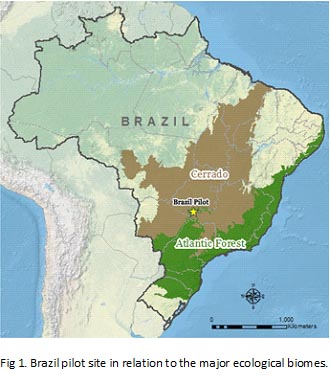
The second pilot site of the
TNC-Dow Collaboration is the Dow-Mitsui joint venture,
Santa Vitória Açúcar e Álcool (SVAA) in Santa Vitória, Brazil. It is located in the western region of Minas Gerais State, on the border between two critically endangered biomes — the
Cerrado and the
Atlantic Forest. This region sits in the heart of Brazil’s agricultural region, where less than 20% of natural vegetation remains that is highly fragmented and poorly protected. SVAA is planning the expansion of sugarcane fields in existing pastureland for the production of ethanol, while adhering to
Brazil’s Forest Code. A federal law that stipulates a minimum proportion of natural vegetation be set aside on privately owned lands, the Forest Code is a key mechanism for conservation in agricultural areas in Brazil. The Collaboration’s pilot efforts have focused on identifying ways that SVAA can expand agricultural production, while simultaneously adhering to environmental legislation and promoting conservation.
Pilot analyses have modeled the following targets and ecosystem services under different land use planning and Forest Code compliance scenarios to evaluate how to most efficiently balance economic and environmental objectives in the region. See links below for additional information on the methodology.
Our research demonstrates that by upping the scale of land-use planning -- from traditional farm-by-farm level to a broader landscape-scale -- agricultural producers can expand production and minimize the cost of compliance with Brazil’s Forest Code: all while protecting more species, storing more carbon, and improving water quality. We also find that economic and environmental conditions can be substantially improved from the current landscape when land use planning jointly targets both biodiversity and ecosystem services while meeting the habitat thresholds required under the Forest Code. These findings suggest that through joint planning for economic and environmental goals at a landscape-scale, Brazil's agricultural sector can expand production and meet regulatory requirements, while maintaining biodiversity and ecosystem service provision.
Stemming from our research, we developed a spatial decision tool, called LegalGEO, to facilitate the implementation of the Forest Code. LegalGEO is an ArcGIS toolbox that applies well-established conservation principles and models to prioritize options for the location of Legal Reserves that promote landscape conservation while easing the data and time commitments involved in this process for landowners and regulators. LegalGEO is publicly available and downloadable at:
http://www.conservationgateway.org/ConservationPractices/lands/science/applications/Pages/default.aspxFor further details on our research, see recent articles published in
Science Advances and
Biological Conservation,
and featured case study in the Energy Sprawl Solutions book, and related
Cool Green Science blog. Further information on LegalGEO can be found in
Applied Geography. Select findings from the Brazil pilot research are also provided in the
TNC-Dow 2014 Annual Progress Report
and the
TNC-Dow 2016 Summary Report.
Lead Scientists/Contributors:
Christina M. Kennedy (1), Leandro Baumgarten (2), Daniela A. Miteva (1), Peter L. Hawthorne (3), Marcelo Matsumoto (2), James R. Oakleaf (1), Kei Sochi (1), and Joseph Kiesecker (1)
3
Institute on the Environment, University of Minnesota, and
Natural Capital ProjectPublications:Kennedy, C.M., Hawthorne, P.L., Sochi, K., Miteva, D.A., Baumgarten, L., Uhlhorn, E.M, and Kiesecker, J. 2017. Biofuels expansion and environmental quality in Brazil. Chapter in
Energy Sprawl Solutions: Balancing Global Development and Conservation. J. Kiesecker and D. Naugle, eds. Island Press, Washington, D.C. 192 pp.
Oakleaf, J.M. Matsumoto, Kennedy, C.M., Miteva, D.A., Sochi, K., Kiesecker, J., and Baumgarten, L. 2017.
LegalGEO: Conservation tool to guide the siting of legal reserves under the Brazilian Forest Code.
Applied Geography 86, 53-65.
Kennedy, C.M., Miteva, D.A., Baumgarten, L., Hawthorne, P.L., Sochi, K., Polasky, S., Oakleaf, J.R., Uhlhorn, E.M., & Kiesecker, J. (2016).
Bigger is Better: Improved Nature Conservation and Economic Returns from Landscape-level Mitigation.
Science Advances, 2, e1501021.
Kennedy, C.M., Hawthorne, P.L., Miteva, D.A., Baumgarten, L., Sochi, K., Matsumoto, M., Evans, J.S., Polasky, S., Hamel, P., Monteiro Viera, E., Ferreira Develey, P., Sekercioğlu, C.H., Davidson, A.D., Uhlhorn, E.M., & Kiesecker, J., 2016.
Optimizing land use decision-making to sustain Brazilian agricultural profits, biodiversity, and ecosystem services.
Biological Conservation, 204, Part B, 221-230.
Reports:The Nature Conservancy and The Dow Chemical Company. 2016.
Working Together to Value Nature 2016 Summary Report.
The Nature Conservancy and The Dow Chemical Company. 2015.
TNC-Dow 2014 Annual Progress Report.Media and Blogs:Cool Green Science (July 7, 2017):
How to feed the world without killing the planet? Ecology, Environment, & Conservation (February 3, 2017):
New Biological Conservation Study Findings Have Been Reported by Investigators at Nature Conservancy (Optimizing land use decision-making to sustain Brazilian agricultural profits, biodiversity and ecosystem services).
The Nature Conservancy (June 15, 2017), Energy Sprawl Solutions, A Global Solutions Special Feature: Biofuels of Brazil: Sustaining production expansion and environmental quality.
Nature.org (December 14, 2016):
Sparks of hope in 2016: 12 signs of progress in a challenging year around the world.
Global Food For Thought (September 20, 2016):
Agricultural growth and habitat preservation can coexist, and Latin America is going to show us how.
Cool Green Science (July 1, 2016):
Scaling-up agricultural planning for conservation in the Brazilian Cerrado.